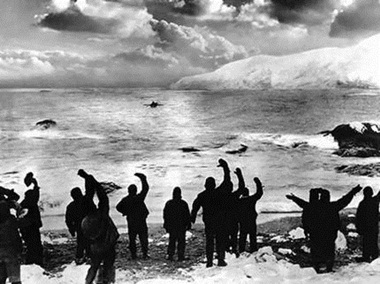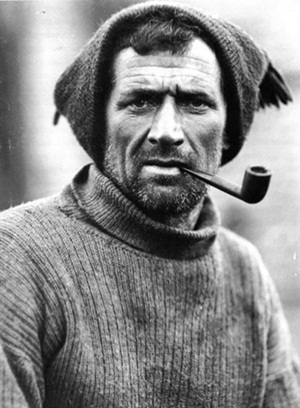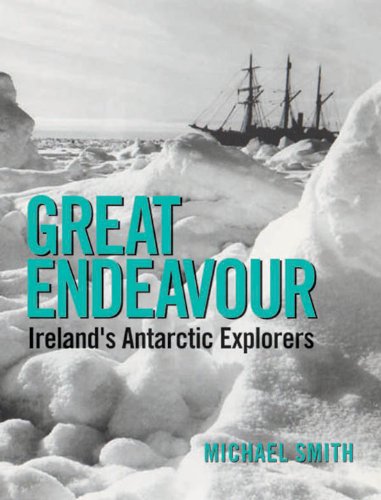The Ice-Men Cometh

Of the multitude of Irish books published this Christmas Great Endeavour, Michael Smith's superb celebration of Irish Antarctic explorers, is the one that deserves a place beneath the tree. By Ed O'Hare
1820 to 1920 saw the golden age of Antarctic exploration. From across the globe an extraordinary group of men came to this kingdom of ice and pushed themselves to the limit in the race to reach the South Pole. Many of these intrepid individuals were Irish. Over the last ten years Michael Smith has restored the reputations of some of these great Irish adventurers and has written biographies of most of the principle figures involved. What no-one has done, until now, is map the entire course of this grand era of discovery, showing the unique role Irishmen played in it. Great Endeavour sets this record straight.
Smith observes that "Almost every noteworthy chapter in the history of Antarctic exploration involves the Irish" and "the outstanding contributions made by different generations of Irish explorers are indispensable to the overall story" of Antarctic exploration. Today the Irish association with the Antarctic outweighs that of explorers from other countries and, in no small part due to Smith himself, it has caught the popular imagination now in a way it never did at the time. Great Endeavour is the first time the tales of all the great Irish Antarctic explorers, from the 18th century to Clare O'Leary, Mark Pollock and Pat Falvey in the present day, have been brought together.
 The opening chapter takes us right back to the dawn of Antarctic discovery. Edward Bransfield was born in 1785 and like most of the men in this book joined the Royal Navy as a teenager. Leaving his home village of Ballinacurra, Co. Cork, Bransfield eventually joined the crew of the Williams, a tiny wooden ship sent to the Shetland Islands in 1820. The Williams became the first ship to venture south in the name of science and when it returned home, having survived deadly encounters with icebergs and freezing fog, the existence of the Antarctic continent had been officially established, a record for furthest southerly latitude had been made while Bransfield's name was given to a mountain peak and a group of islands.
The opening chapter takes us right back to the dawn of Antarctic discovery. Edward Bransfield was born in 1785 and like most of the men in this book joined the Royal Navy as a teenager. Leaving his home village of Ballinacurra, Co. Cork, Bransfield eventually joined the crew of the Williams, a tiny wooden ship sent to the Shetland Islands in 1820. The Williams became the first ship to venture south in the name of science and when it returned home, having survived deadly encounters with icebergs and freezing fog, the existence of the Antarctic continent had been officially established, a record for furthest southerly latitude had been made while Bransfield's name was given to a mountain peak and a group of islands.
Francis Crozier, from Banbridge Co. Down, joined the navy at 14. He was, in Smith's words, "the most accomplished and prolific" Arctic and Antarctic explorer of the 19th Century. After spending years trying to locate the North-West Passage, a sea route linking the Atlantic and Pacific oceans, he took charge of the Terror, one of two vessels sent to explore Antarctica. The Terror's four year voyage provided the first detailed maps and magnetic charts of the continent and enough scientific data to keep the Royal Society busy for 25 years. Tragically, on a doomed subsequent expedition Crozier and his crew perished in the frozen wilderness.
Ernest Shackleton's story has been told many times but becomes more impressive with each retelling. Raised on his family's farmhouse in Kildare, Shackleton's adventurous spirit saw him join the navy at 16. His abilities as a seaman earned him a posting to the Discovery, Robert Scott's 1902 Antarctic expeditionary vessel. Shackleton accompanied Scott on his first bid for the South Pole and barely made it back alive. When Shackleton headed south again it was he was in command of his own Antarctic expedition aboard the Nimrod in 1907. On this occasion Shackleton made a journey over the Barrier, the vast sheet of ice surrounding one side of Antarctica, climbed the tallest Antarctic mountain, located the magnetic South Pole and nearly reached it on foot.
Shackleton's greatest achievement was the famous 1914 Trans-Antarctic Expedition. When his ship the Endurance became caught in ice and was crushed Shackleton and his men found themselves marooned thousands of miles from the civilised world. The Boss's magnificently understated response was "So now we'll go home." Thus began his now mythic 1,800 mile rescue mission from Elephant Island, where the bulk of the men remained, across a notorious stretch of sea to South Georgia and then over the mountainous island itself on foot to reach a whaling station. All this did nothing to dampen Shackleton's unquenchable love of adventure but he would never undertake such a deed again. He died on South Georgia just as his third expedition was about to begin six years later and was buried beneath the ice, his true home.
 Tom Crean, another legendary figure, came from Anascaul, Co. Kerry. He went on five sledging trips while serving Scott on the Discovery voyage and was a member of one of the support groups on Scott's polar bid. When his two companions got into difficulties Crean bravely went ahead the final 35 miles without stopping to raise the alarm, an act which saved them. "My long legs did the trick" he said afterwards. On the 1914 voyage Crean was the indomitable right-hand man of his old friend Shackleton and was one of the three who made the heroic journey from Elephant island to South Georgia, an achievement unparalleled in modern exploration.
Tom Crean, another legendary figure, came from Anascaul, Co. Kerry. He went on five sledging trips while serving Scott on the Discovery voyage and was a member of one of the support groups on Scott's polar bid. When his two companions got into difficulties Crean bravely went ahead the final 35 miles without stopping to raise the alarm, an act which saved them. "My long legs did the trick" he said afterwards. On the 1914 voyage Crean was the indomitable right-hand man of his old friend Shackleton and was one of the three who made the heroic journey from Elephant island to South Georgia, an achievement unparalleled in modern exploration.
The other men Great Endeavour profiles, Patrick Keohane, Robert Forde and Tim and Mortimer McCarthy, all hailed from Cork and all were valued members of Scott and Shackleton's expeditions. They were consummate mariners who could turn their hands to anything, from carpentry to cooking to building shelters and training pack animals, and they kept jokes and songs flowing even in the most terrible circumstances. The story of Mortimer McCarthy is particularly incredible. After lying about his age he went to sea at twelve in 1894. In 1910 he became a last minute addition to the crew of Scott's Terra Nova expedition and, as helmsman, saved it from disaster several times. After receiving the Silver Polar Medal from King George V he was sent to the Arctic Circle on what may have been a mission to spy on German activities there. He eventually settled in New Zealand, spent a total of seventy years at sea and in 1962 became the oldest man ever to travel to the Antarctic when the US navy invited him to return to the site of Scott's camp.
The exploits recounted in Great Endeavour are phenomenal. How these men stoically faced interminable hardship and suffering with such perpetual optimism is difficult to imagine. All of Smith's well-paced accounts are thoroughly exhilarating. At the same time, he does not indulge in mindless hero-worshipping. He points out that three men on the Aurora, the Endurance's sister expedition, died due to Shackleton's poor preparation. Smith is also sensitive to the often sheltered lives many of these men lived when they returned home noting that because they had served the Crown most of them could never speak about there adventures. Dynamically written and lavishly illustrated with many hitherto unseen photographs, maps and archive documents, Great Endeavour is a fantastic tribute these genuine heroes deserve.
 Great Endeavour: Ireland's Antarctic Explorers by Michael Smith
Great Endeavour: Ireland's Antarctic Explorers by Michael Smith
Published by the Collins Press
340 pages
30 EURO
